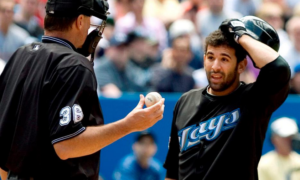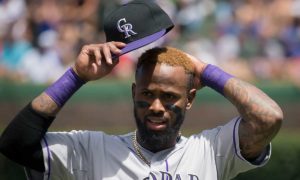Trade Retrospective: Rockies trade Troy Tulowitzki to the Blue Jays

For the fifth straight offseason, I am taking a look back on some of the biggest trades from years past. Check out all my previous entries at Beyond the Box Score here.
Shortly before the 2015 trade deadline, the Rockies decided to trade one of their best players in franchise history, and a guy that caught OTBB’s eye back in its infancy. They sent Troy Tulowitzki and LaTroy Hawkins to the Blue Jays in exchange for José Reyes, Jeff Hoffman, Miguel Castro, and Jesús Tinoco.
In this trade retrospective series, trades will be evaluated based on what was known at the time. That is the only fair, logical way to evaluate trades and remove luck from the equation; we’re evaluating process over results. Having said that, we will still take a look at how the trade worked out for both parties.
The Deal
In late July 2015, the Rockies were in last place. Their season was effectively over. Tulowitzki was in his 10th season with the team, and was already third all-time team leader in WAR with 39.5, behind Hall of Famer Larry Walker and borderline Hall of Famer Todd Helton. He was also 30 years old and had an extensive injury history. Over the three seasons prior, he combined for only 264 games played. Thankfully when he played, he was one of the best players in baseball.
However, Tulo was having a bit of a down year at the time of the trade, hitting .300/.348/.471, which amounts to just a 106 wRC+ in Coors Field. To be fair, he had a 1.7 WAR, so he was doing well, just not at the MVP-caliber levels we were accustomed to. Even though they weren’t ready to go into a full rebuild, they clearly saw an opportunity to move on from their oft injured, aging star with five years and $98 million left on his contract. This really was not too similar to their disgraceful recent trade of Nolan Arenado.
The Blue Jays were hanging around .500 in what was a fairly competitive AL East. The Yankees had a seven-game lead, but the Orioles, Rays, and Jays were all hanging around the same record. Despite their explosive offense, Reyes was not pulling his weight. He had long stop being a competent fielder at shortstop. A line of .285/.322/.385 isn’t bad for a shortstop, but he was giving so much of it back on the field. To be fair, he wasn’t bad, but Tulo was better and two years younger.
The Jays had a bigger need at pitcher, but this trade helped indirectly. The huge improvement in defense between Tulo and Reyes was sure to help out the pitching staff.
Obviously this was a risk by the Jays given Tulo’s injury history, but what I really like about this trade is that they chose to take on salary rather than part with better prospects. The difference between Tulo’s and Reyes’ remaining salary was $50 million! Taking on that salary is well worth hanging on to your best prospects, who for the Jays was Aaron Sánchez and Daniel Norris. The best prospect they parted with was Hoffman, who many saw as a top 100 prospect but was not on the level of Sánchez or Norris.
The major thing this trade has in common with the Arenado one is the Rockies preferring money over talent. With Trevor Story on his way, the team didn’t need Reyes, but what they did need — what they’ve always needed — is pitching. They should’ve offered to eat more salary in exchange for at least one of Sánchez or Norris instead of the pitching prospects they actually got.
This was a bit of a strange trade, honestly. The Jays did well in choosing to take on salary instead of parting with their best prospects, but taking on Tulo was awfully risky.
The Results
Tulo only hit .239/.317/.380 the rest of the way, which was slightly worse than what the Jays were getting from Reyes, but they got a better glove. The less said about his postseason performance, the better.
The Jays got a nice full season from Tulo in 2016, getting average offense and great fielding resulting in 3.2 WAR over 131 games. After that, though, things went downhill.
In 2017, Tulo played in only 66 games, but was still productive despite his .249/.300/.378 line thanks to his defense. Then things got worse in 2018, as he missed the entire year as a result of bone spurs in his ankle that required surgery. The Blue Jays saw the aging, injured shortstop as a sunk cost, and decided to eat the two years and $38 million left on his contract.
The Yankees decided to give Tulo a chance in 2019, but it didn’t go anywhere, so he retired. I lamented what his career could’ve been at the time. The guy could’ve been an upper level Hall of Famer had he been able to stay healthy.
Reyes stunk in Colorado, so they understandably didn’t bring him back for 2016. Despite serious allegations of domestic violence levied against him, the Mets did a Mets thing and decided to bring him back to where he started. And again, because they’re the Mets they brought him back for the 2017 and 2018 seasons, even though he was terrible and an alleged domestic abuser. In three seasons back in Queens, he hit .238/.305/.399, was terrible defensively (-21 DRS in 2017!), and was worth a total of 0.3 WAR. I’m the money-doesn’t-matter guy, but spending over $24 million for that when it was so predictable leaves me at a loss.
Hawkins finished his 21-year career on a high note. A 3.86 RA9 at Coors Field is very impressive, even if it is just 16.1 IP.
Hoffman debuted in 2016 and played with the Rockies through last year, split between the rotation and the bullpen. Unfortunately, it went poorly. A 6.95 RA9 is bad even for Coors Field, and while his peripherals weren’t terrible, they were worse than average. He is now part of the Reds’ rotation.
Castro stayed in Colorado through 2016, then pitched in Baltimore through late 2020, and finally ended his season with the Mets where he’ll remain in 2021. He’s been just okay. He has a career 4.67 RA9 and a not very good 19.0 K%. His biggest problem is his control, as he has walked about 12% of the batters he’s faced in his career.
Tinoco didn’t debut until 2019, and then the Rockies traded him to the Marlins in August 2020. They designated him for assignment at the end of the month. The Rockies decided to bring him back by claiming him off waivers, and then designated him for assignment themselves later that year. Weird. He’s still with the organization, but will not be on the major league roster to start the year. He hasn’t been given much a chance, but his peripherals are poor. When you have a 15 BB% and your strikeout percentage isn’t much higher than that, that’s really saying something.
Again, this was a strange trade. The risk associated with Tulo blew up in the Blue Jays’ faces, but all it cost them was money, which is plentiful in the modern game. The prospect cost was minimal. Still, you have to credit the Rockies for parting with Tulo at the right time and saving all that money. I doubt the Arenado trade will look that good when it’s all said and done.
















